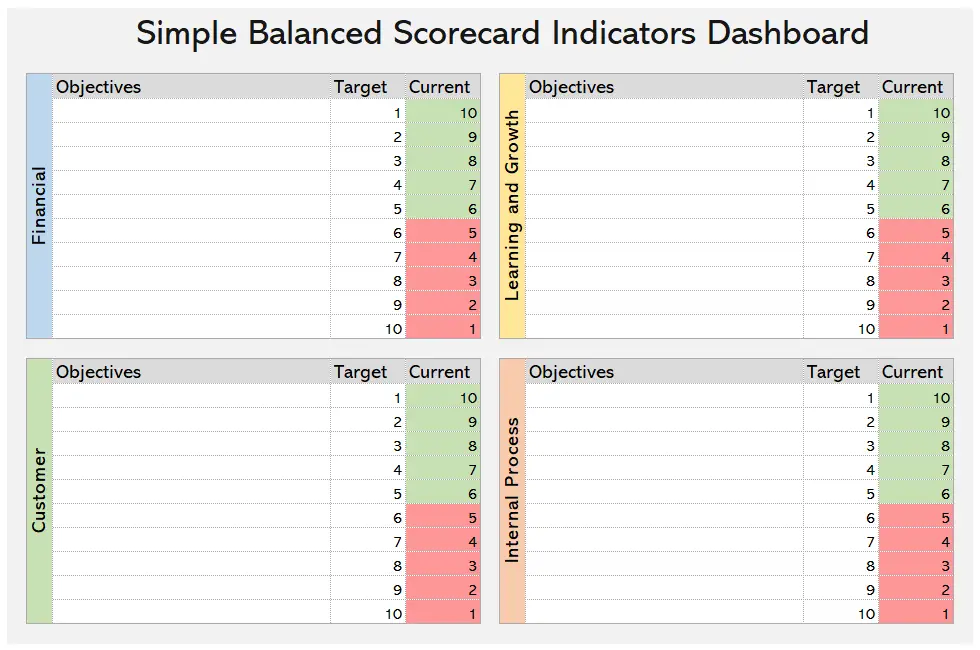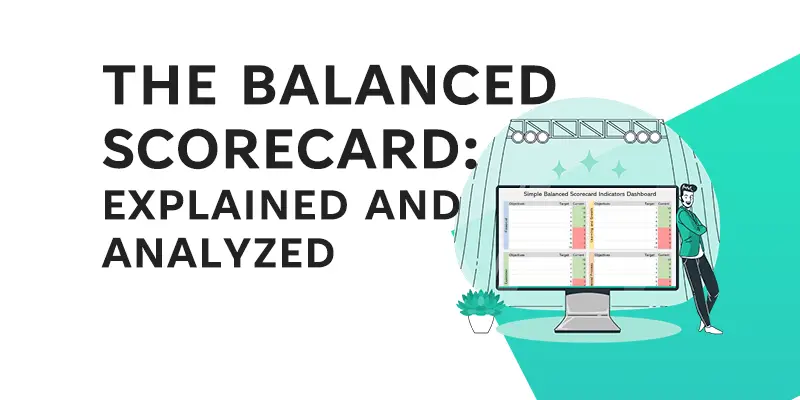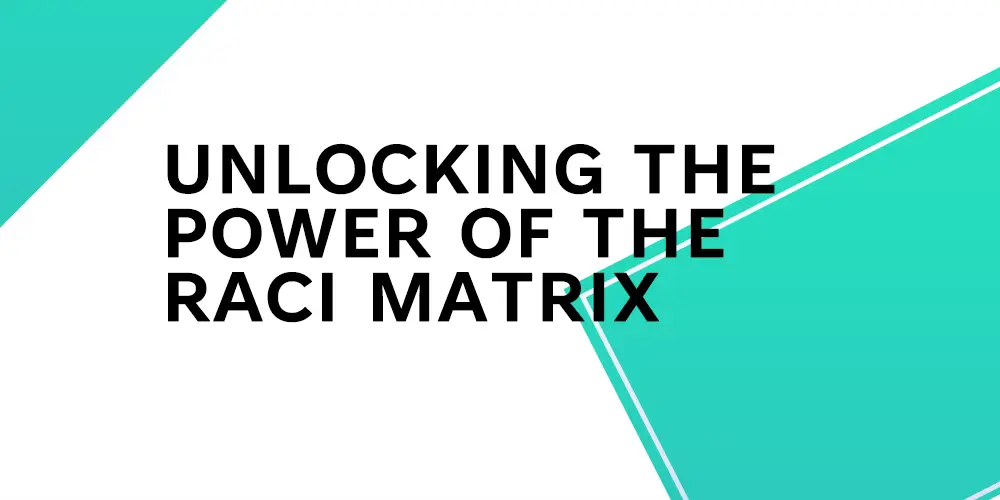The Balanced Scorecard has emerged as a powerful strategic management tool that is revolutionizing the way businesses measure and achieve success. In today’s world of increasing complexity and competition, financial metrics alone are no longer sufficient to assess overall performance. The Balanced Scorecard is a multidimensional approach that combines four critical perspectives to capture the essence of a company’s strategic objectives. This blog post delves into the unique significance and practical implementation of these perspectives – Financial, Customer, Internal Processes, and Learning and Growth.
This comprehensive analysis will shed light on how organizations can align their vision with tangible measures, foster a culture of continuous improvement, and unleash the potential for sustained success in an ever-changing landscape by revealing how they work in harmony.

The Financial Perspective
The Financial Perspective in the Balanced Scorecard focuses on an organization’s financial health and performance. It aims to provide answers to critical questions such as “Are we financially successful?” and “Are we adding value to our shareholders?” This viewpoint is critical because financial stability is a critical component of any business’s long-term viability and growth.
Key Financial Metrics and KPIs
Specific financial metrics and Key Performance Indicators (KPIs) are used in this perspective to measure the company’s financial performance. Revenue, profitability, return on investment (ROI), cash flow, and cost management are examples of metrics. KPIs serve as important indicators of whether an organization is on track to meet its financial goals.
Linking Financial Goals to Overall Strategy
The Financial Perspective does not exist in isolation; it is linked to the overall organizational strategy. Financial objectives are directly related to the company’s strategic objectives. For example, if the strategy involves increasing market share, the Financial Perspective may include revenue growth or cost-cutting goals to support that strategic direction.
Example Illustrating the Financial Perspective in Action:
Consider a hypothetical company, “TechGadgets Inc.,” which wishes to expand its market presence. They would set goals in the Financial Perspective such as increasing sales revenue by 20% over the next year and improving profit margins by 5%. They would also monitor key performance indicators such as gross profit percentage and return on marketing investment. TechGadgets Inc. can ensure that their strategic initiatives are contributing positively to their financial success by closely monitoring these financial indicators.
In summary, the Balanced Scorecard Financial Perspective provides a clear picture of how an organization’s financial performance aligns with its overall strategy. It keeps businesses financially healthy and on track to meet their objectives, making it an essential component of the larger Balanced Scorecard framework.
Examples of Financial Perspective KPIs
- Revenue Growth Rate: This metric calculates the percentage increase in total revenue over a given time period.
- Profit Margin: The percentage of profit earned on each dollar of revenue.
- Return on Investment (ROI): A measure of an investment’s profitability in relation to its cost.
- Cash Flow from Operations: Tracks the amount of money generated or spent in daily business operations.
- COGS as a Percentage of Revenue: Indicates the percentage of revenue spent on producing goods or services.
The Customer Perspective
The Balanced Scorecard’s Customer Perspective is all about understanding and meeting the needs of the organization’s customers. It focuses on critical questions such as “Are we giving our customers what they want?” and “How satisfied are our customers with our products or services?” The Customer Perspective assists businesses in prioritizing customer satisfaction and developing long-term relationships with their target audience.
Identifying Customers Needs and Expectations:
Companies must first identify what their customers truly need and expect in order to excel in the Customer Perspective. This entails actively listening to customer feedback, conducting surveys, and analyzing market trends to learn about customer preferences. Understanding these needs is critical for effectively tailoring products or services to meet customer demands.
Customer-Focused Metrics and KPIs:
Specific metrics and Key Performance Indicators (KPIs) are used in this perspective to measure customer satisfaction and loyalty. Customer retention rate, customer complaints, Net Promoter Score (NPS), and customer lifetime value are examples of such metrics. These indicators provide a clear picture of how well the organization serves its customers and whether changes are required.
Balancing Short-Term and Long-Term Customer Objectives:
The Customer Perspective strikes a balance between short-term gains and the development of long-term relationships. While organizations must address immediate customer needs, they must also focus on long-term customer loyalty. A satisfied and loyal customer base can result in repeat business and positive word-of-mouth referrals, which can contribute to long-term growth.
Example of Customer Perspective Impact:
Consider the fictional restaurant chain “Delicious Bites,” which wishes to improve its Customer Perspective. They pay attention to customer feedback and discover that many people want healthier menu options. To address this, the restaurant launches a new menu of nutritious dishes aimed at attracting health-conscious customers. As a result, “Delicious Bites” sees an increase in customer satisfaction, positive online reviews, and increased customer loyalty. These results demonstrate how prioritizing customer needs and implementing data-driven changes improves the overall success of the business.
Finally, the Balanced Scorecard Customer Perspective emphasizes the importance of putting customers at the center of business decisions. Organizations can create a customer-focused culture that drives success and growth by understanding their needs, measuring their satisfaction, and aiming for long-term relationships.
Examples of Customer Perspective KPIs
- Customer Satisfaction Score (CSAT): Measures a customer’s satisfaction with a product or service via surveys or feedback.
- Net Promoter Score (NPS): Indicates the likelihood that customers will recommend the company to others.
- Customer Retention Rate: The percentage of customers who continue to do business with the company after a certain period of time.
- Customer Lifetime Value (CLV): Estimates the total revenue a customer will generate over the course of their relationship with the company.
- Customer Complaint Resolution Time: This metric measures the amount of time it takes to resolve customer complaints or issues.
The Internal Process Perspective
The Balanced Scorecard’s Internal Processes Perspective focuses on the organization’s key internal activities and processes. Its goal is to ensure that these internal processes are efficient, effective, and aligned with the company’s overall strategic goals. Businesses can improve their overall performance and provide value to their customers by optimizing internal processes.
Identifying Critical Internal Processes for Business Success:
Companies, according to this viewpoint, identify the core internal processes that have the greatest impact on their success. Product development, manufacturing, supply chain management, customer service, and any other activities critical to delivering products or services to customers are examples of these processes. Businesses can prioritize their improvement efforts by identifying these critical processes.
Measuring Process Efficiency and Effectiveness:
Specific metrics and Key Performance Indicators (KPIs) are used to assess the success of internal processes. These KPIs assess the efficiency (how effectively resources are used) and effectiveness (how well the process achieves its goals) of each identified internal process. Cycle time, error rates, resource utilization, and customer response time are examples of metrics.
Continuous Improvement and Innovation:
Organizations are encouraged to focus on continuous improvement and innovation under the Internal Processes Perspective. Companies can reduce costs, improve quality, and streamline operations by regularly analyzing internal processes and seeking ways to optimize them. Embracing innovation also enables businesses to stay ahead of the competition and adapt to changing market demands.
Example of Improvements Through the Internal Process Perspective:
Consider the fictional manufacturing company “TechGear,” which is plagued by production delays and high defect rates. They identify these issues as critical internal processes affecting their success by employing the Internal Processes Perspective. “TechGear” invests in employee training, adopts new automation technology, and redesigns their production line layout to increase efficiency. As a result, they have significantly fewer defects, shorter production times, and higher output. This success increases not only customer satisfaction but also the company’s financial performance.
To summarize, the Balanced Scorecard’s Internal Processes Perspective assists businesses in focusing on internal activities that drive success. Organizations can optimize their operations and provide better value to customers by identifying critical processes, measuring their efficiency and effectiveness, fostering continuous improvement, and embracing innovation. This, in turn, contributes to the company’s overall success and competitiveness in the marketplace.
Examples of Internal Process Perspective KPIs:
- Cycle Time: The time it takes to complete a specific process from beginning to end.
- First-Time Quality: Determines the percentage of products or services that meet quality standards the first time.
- Process Efficiency Ratio: A ratio that compares a process’s output to its input to determine its efficiency.
- On-Time Delivery Rate: The percentage of orders delivered on or before the promised delivery date.
- Employee Training Hours: Tracks the number of hours spent on employee development and training.
The Learning and Growth Perspective:
The Balanced Scorecard’s Learning and Growth Perspective focuses on the development and improvement of an organization’s people and capabilities. It recognizes the importance of employees in achieving business success. This viewpoint seeks to foster a positive and supportive work environment that promotes continuous learning, personal growth, and skill development.
Focusing on Employee Development and Capabilities:
Companies prioritize employee growth and development in this perspective. They spend money on training programs, workshops, and resources that help employees improve their skills, knowledge, and abilities. Organizations ensure that their workforce is prepared to take on new challenges and contribute effectively to the company’s success by doing so.
Measuring Employee Satisfaction and Engagement:
Organizations use metrics such as employee satisfaction and engagement to assess the effectiveness of employee development initiatives. These metrics assess how satisfied and committed employees are to their jobs and the organization. High levels of satisfaction and engagement imply a positive work environment and a workforce that is more likely to remain motivated and productive.
Aligning Learning with Strategic Objectives:
The Learning and Growth Perspective connects employee development to the overall strategic goals of the company. Organizations identify the skills and competencies needed to support their strategic goals and then design learning programs to meet these specific requirements. This alignment ensures that employee development directly contributes to the achievement of larger business goals.
Example of a Company Fostering Growth with the Learning and Growth Perspective:
Consider a fictitious tech startup called “InnovateTech,” which emphasizes the Learning and Growth Perspective. They provide online courses, workshops, and mentorship programs to their employees in order to develop technical expertise and foster creativity. As a result, “InnovateTech” has increased employee engagement, reduced turnover, and fostered an innovative culture. Employees become more adept at problem solving, which leads to the development of cutting-edge products and solutions, increasing the company’s market competitiveness.
Finally, the Balanced Scorecard’s Learning and Growth Perspective emphasizes the importance of nurturing employees’ development and capabilities. Organizations can create a workforce that is motivated, engaged, and equipped to drive the company’s success in a dynamic and competitive business landscape by fostering a culture of continuous learning and aligning employee growth with strategic goals.
Examples of Learning and Growth Perspective KPIs:
- Employee Satisfaction Score: This metric assesses employees’ satisfaction and happiness in the workplace.
- Employee Turnover Rate: Determines the percentage of employees who leave a company during a given time period.
- Skill Development Index: Determines the extent to which employees’ skills and capabilities have improved.
- Employee Engagement Index: Assesses employees’ commitment and involvement in their jobs and organizations.
- Innovation Rate: The number of new ideas or innovations implemented in the organization over a period of time is tracked by the innovation rate.
Integrating the Four Perspectives:
The Balanced Scorecard combines four critical viewpoints: financial, customer, internal processes, and learning and growth. These points of view are interconnected, which means they influence and rely on one another. Customer satisfaction, for example, can lead to increased financial success, which allows for investment in employee development and process improvement. Understanding these links allows organizations to see the big picture and make more informed decisions.
Cascading Objectives from Top-Level to Operational Levels:
The Balanced Scorecard combines four critical viewpoints: financial, customer, internal processes, and learning and growth. These points of view are interconnected, which means they influence and rely on one another. Customer satisfaction, for example, can lead to increased financial success, which allows for investment in employee development and process improvement. Understanding these links allows organizations to see the big picture and make more informed decisions.
How the Balanced Scorecard Promotes a Balanced and Holistic Approach:
The Balanced Scorecard encourages organizations to consider a diverse set of metrics rather than focusing solely on financial results. Companies can get a more complete picture of their performance by including customer satisfaction, internal process efficiency, and employee development. This approach ensures that improvements are made across the board, resulting in more sustainable growth.
Benefits of the Integrated Approach for Sustainable Success:
The Balanced Scorecard’s integrated approach has several advantages.
First, because all objectives are linked to the strategic goals, it helps organizations stay focused on their overall strategy.
Second, because everyone has the same goals, it encourages communication and collaboration across departments.
Third, the Balanced Scorecard provides early warning signs when performance in one area negatively impacts performance in others, allowing for timely corrective actions.
Finally, a balanced and holistic perspective allows for better decision-making, which leads to long-term success and resilience in a dynamic business environment.
In summary, integrating the Balanced Scorecard’s four perspectives results in a unified and strategic framework for organizations to measure and achieve success. Businesses can work cohesively towards their vision, ensuring sustainable and prosperous outcomes, by understanding the connections between perspectives, cascading objectives, promoting balance, and reaping the benefits of a holistic approach.
Conclusion
Finally, the Balanced Scorecard provides a strong framework for organizations to achieve success by taking a balanced and strategic approach. Businesses can align their objectives, prioritize key measures, and foster a culture of continuous improvement by integrating the Financial, Customer, Internal Processes, and Learning and Growth Perspectives. This comprehensive methodology enables businesses to assess their performance from various perspectives, identify interdependencies, and make informed decisions that lead to long-term growth and competitive advantage.
The Balanced Scorecard ensures that organizations remain agile and responsive in an ever-changing marketplace by emphasizing customer satisfaction, process efficiency, employee development, and financial health. Companies that embrace this holistic system unlock the potential to thrive in the face of adversity, maximize their potential, and chart a course for long-term success.








